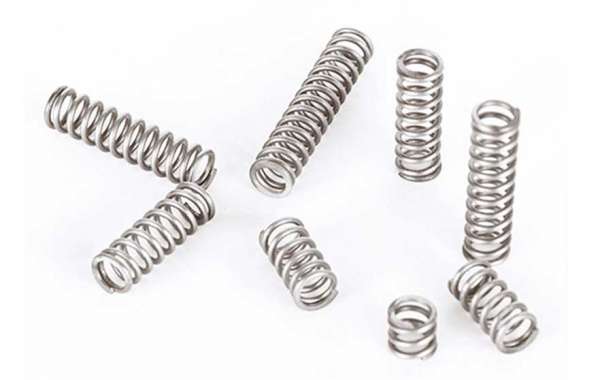Stainless steel spring refers to a spring that can work in electronics, air, steam, water and other weak corrosive media and acid, alkali, salt and other chemical etching media. GB/T 1239.2-2009 Cold roll cylindrical spring technical conditions. GB/T 18983-2003 Oil quenching and ignition spring steel wire. JB/T 10802-2007 Spring Jets is strengthened.

The spring factory designed and produced various types of stainless steel spring. Stainless steel spring is suitable for working environments such as high and low temperature, corrosion resistance. The materials mainly include 130m, 304,302,301,316,316L, 321.202.201.430.420, 631, etc.
Stainless steel spring is an elastic element that requires corrosion resistance in many industries such as chemical machinery and electronics in many industries such as chemical machinery and electronics. Or the kinetic energy is converted into elastic potential energy, and the deformation of the stainless steel spring disappears and restores the original shape after uninstalling, and transform the deformation energy into mechanical or kinetic energy.
Stainless steel spring is divided into stretching spring, compressed spring, reversing spring and precision spring according to the stress properties. Ring spring and so on. Ordinary cylindrical springs can be made into various types due to simple manufacturing and can be made according to the loading conditions. The structure is simple, so it is the most widely used. The spring should generally have high elasticity, fatigue limit, impact toughness, and good thermal and corrosion -resistant properties. The commonly used materials are the same as above. The cold roll method is commonly used in the diameter of the spring wire to be less than 20 mm. After the stainless steel spring is made, the pressure or polishing should be performed, which can improve the loading capacity and surface smoothness of the spring.
Commonly used materials Domestic stainless steel 304,302,301,316,316L, 321.202.201.430.420,
304 stainless steel is a common material in stainless steel, with a density of 7.93 g/cm3. The industry is also called 18/8 stainless steel. High temperature resistance is 800 ° C, which has the characteristics of good processing performance and high toughness. It is widely used in the industry and furniture decoration industry and the food medical industry.
304L stainless steel is also known as ultra -low -carbon stainless steel. It is a versatile stainless steel material. It is widely used to make equipment and parts that require good comprehensive performance (corrosion resistance and molding).
316 stainless steel is a type of austenite stainless steel. Because of the addition of MO elements, it has greatly improved its corrosion resistance and high temperature strength. High temperature resistance can reach 1200-1300 degrees, which can be used under harsh conditions.
631 stainless steel is my country's 0CR17NI7AL. 631 is a semi -austenite precipitated hardening stainless steel. It is a stainless steel with unstable Auspace. This steel is solid -soluble. Adjustment and treatment around the degree, the Austenite can transform the martyl, and then perform time -effectiveness. The second phase can be precipitated on the martensite matrix to strengthen the steel.
1. Thermal treatment of Austenite stainless spring steel
(1) Solid solution treatment
Standard soluble treatment specifications and equipment of Austeenia stainless spring steel
Material brand
Treatment temperature ℃
cooling method
1cr18ni9
Baseball: 1100 ~ 1150
Water -cooled
Board: 1080 ~ 1130
Water or oil
Band: 1020 ~ 1070
Cool water, cold oil or cold air
1cr18ni9ti
Baseball: 1060 ~ 1140
Water -cooled
Board: 1050 ~ 1130
Water or oil
Band: 1020 ~ 1070
Cool water, cold oil or cold air
0CR17NI14MO2
1020 ~ 1120
Cool water, cold oil or cold air
0CR18NI12MO2TI
1020 ~ 1100
Cool water, cold oil or cold air
1CR18NI12MO2TI
1020 ~ 1100
Cool water, cold oil or cold air
(2) Stable recovery treatment
Austenite stainless spring steel stable recovery treatment specifications and equipment
Material brand
Treatment temperature ℃
Insulation time (h)
1cr18ni9
430 ~ 480
2H
Vacuum stove
or
Time -effective stove
1cr18ni9ti
0CR17NI14MO2
380 ~ 480
2N
0CR18NI12MO2TI
1CR18NI12MO2TI
2. Thermal treatment of martensite stainless spring steel
(1) Matriot stainless spring steel for preparation thermal treatment of martensite stainless spring steel belongs to martensite phase change to strengthen steel
Martiner stainless spring steel preparation thermal treatment process
Material brand
Incomplete annealing
Low temperature annealing
Heating temperature ℃
Cooling medium
British hardness indentation mm
Heating temperature ℃
Cooling medium
British hardness indentation mm
2CR13
870-900
After cooling with the furnace to 600 ° C
≥4.4
730 ~ 780
Air
≥4.0
3CR13
≥4.2
730 ~ 780
≥4.0
4CR13
≥4.0
730 ~ 780
≥4.0
1cr17ni2
670 ~ 690
≥3.5
(2) The quenching and ignition treatment of martensite stainless spring steel
The final thermal treatment of the springs after the spring steel is made of springs is quenching and recovery.
The final thermal treatment process of martensite stainless spring steel is commonly used
Material brand
Quench
Return to fire
Hardness (HRC)
Heating temperature ℃
Cooling medium
Heating temperature ℃
Cooling medium
2CR13
1000 ~ 1040
Oil
300 ~ 480
Air
3CR13
1000 ~ 1040
Oil
300 ~ 480
Air
40 ~ 46
3CR13MO
1020 ~ 1060
Oil
220 ~ 300
Air
46 ~ 50
4CR13
1000 ~ 1050
Oil
320 ~ 450
Air
45 ~ 52
1cr17ni2
1000 ~ 1020
Oil
340 ~ 360
Air
3. Precision hardening stainless spring steel thermal treatment
Settlement and hardening stainless spring steel is enhanced by martial arts phase change and precipitation analyzes the comprehensive reinforcement of the two, so the basic thermal treatment process is solid -soluble treatment and timeliness.
For the semi -Austrian sports steel, the room temperature after the solid -soluble treatment is unstable, and the austenitic transformation is not completed, and it is not fully strengthened. Therefore Stabilizing the austenite to martenite. Commonly used adjustable treatment: regulatory treatment (T treatment), cold treatment (R treatment), and plastic treatment (C treatment).
1. Uniform and beautiful surface state.
2. Good formability, uniform elasticity.
3. High -plasticity, fatigue strength, good thermal corrosion resistance.
4. The surface status of the material is selected by the user: naked lines, nickel -plated spring lines, plating resin spring lines, and stainless steel springs are divided into bright surfaces, fog surfaces, and half -bright surfaces. Customers can choose according to the requirements of the precision and beauty of the product.
5. Whether it is a magnetic or weak stainless steel spring.
All products can be widely used in electronics, home appliances, industry, civilian and other products.
There are two ways to use stainless steel spring to remove oil and oxide.
1. Immersed the stainless steel spring into a plastic container with metal cleaning agent A (cleaning agent A and clear water dilution of 1: 1 or 1: 2) with water diluted with water. It is advisable to have a metal color, and the soaking time should not be too long. Take it out and wash with water. In this way, the surface of stainless steel spring has a sub -light effect.
2. In the ultrasonic equipment, the proportion of cleaning agents and water is about 1:30. The time is suitable for the spring surface of the spring surface, and the oxygen peroxide recovers metal. Effect.
The above two methods can be suitable for spring with high precision.
3. Washing agent A Put in the vibration light decoration machine with coarse abrasives and spring or in hexagonal drums (the volume ratio of spring and coarse abrasive is 1: 3, and the amount of cleaning agent is 1%-2%of the spring weight of the spring ) After grinding and polishing, wash with water, and the scratches on the surface of the spring are gone, which increases the smoothness of the spring surface. However, this method should not be used for spring with high precision.
The second step is to give the stainless steel spring light:
Put the light brilliant B in a rough abrasive vibration light decoration machine or in the hexagonal drum (the volume ratio of the spring and the abrasive is 1: 3, and the amount of light brilliant B is about 1%-2%of the spring weight. The more the time, the more After the long), after polishing, remove it with water and dry it. So the surface of the stainless steel spring is like a nickel -plated light -plated person, and will never fade.
Chemical polishing is a common surface treatment process for stainless steel. Compared with the electrochemical polishing process, the advantage of its largest stainless steel polishing product is that it does not require DC power supply and special fixture. It can polish complicated parts with high productivity. In terms of functionality, in addition to obtaining the surface of physical and chemical cleanliness, chemical polishing can also remove the mechanical damage layer and stress layer of the stainless steel surface to obtain the surface of the mechanical cleanliness. Mechanical strength, extending the service life of the parts. Since the patent of stainless steel chemical polishing in the early 1940s, many formulas have been in the world so far, but people are still difficult to be in actual application. Because there are many stainless steel varieties, and different brands of stainless steel have different corrosion laws, and the same solution cannot be adopted, so there are many types of stainless steel chemical polishing solutions. Basic composition of chemical polishing solutions includes corrosive agents, oxidants and water. The corrosion agent is the main ingredient. If stainless steel is dissolved in the solution, polishing cannot be performed. The oxidant and additives can inhibit the process and make the reaction in the direction that is conducive to polishing. Water is regulated on the concentration of the solution to facilitate the spread of the product. Whether the stainless steel chemical polishing can be carried out smoothly depends on the reasonable cooperation of the above ingredients.
Stainless steel electrolytic polishing is to hang stainless steel products on anode, and perform anode electro -electro -electro -electrocular stainless steel polishing operation in the electrolytic polishing solution. Electrolytic polishing is a special anode process. During the entire anode electrolyte polishing process, the surface of stainless steel products perform two contradictory processes at the same time, that is, the metal surface oxidation film is constantly generated and dissolved. However, the conditions of the protruding parts of the stainless steel products and the chemical film of the concave parts are different. Due to the anode solubility, the concentration of metal salt in the anode area has continued to increase. Mucous membrane layer. The thickness of the thickness of thick mucosa on the surface of the product is different, and the current of the anode micro surface is unevenly distributed. The current density of the micro -convex is large and the dissolution is fast, so that the surface of the product surface is burning or micro -convex, and the level of the product is solid to the leveling; Due to different current density distribution, the surface of the product is constantly forming film and dissolving at different rates. Two opposite processes on the surface of the anode, film formation and dissolution, the continuous generation and dissolution of the passivation film, the surface of stainless steel products is flattened, reaching a highly smooth and gloss appearance, satisfying the purpose of polishing the surface of stainless steel products.









